2. 江西师范大学鄱阳湖湿地与流域研究教育部重点实验室, 南昌 330022
2. Key Laboratory of Poyang Lake Wetland and Watershed Research, Ministry of Education, Jiangxi Normal University, Nanchang 330022, China
粒径小于5 mm的塑料被称为微塑料, 微塑料在环境中无处不在, 是当今水生环境中不可忽视的新型污染物[1].环境中微塑料具有持久性、普遍性的特征, 同时, 微塑料会吸附一些疏水性材料及其它污染物, 如多氯联苯等苯系物、重金属污染物等, 成为更小、毒性更持久的污染物, 从而危害河流、湖泊、海洋等水生生态系统的健康[2, 3].此外, 微塑料可被生物摄入进入食物链而对生物和人类食物的安全构成威胁[4].因此, 准确量化微塑料在水生环境中及生物体内的产生、分布及其所带来的生态风险日益重要.
鄱阳湖是中国的第一大淡水湖, 是我国公布的首批国家重点湿地保护地区之一, 也是世界上最大的鸟类保护区.近年来, 随着鄱阳湖流域区域的快速发展, 江湖关系发生了较大改变, 鄱阳湖也出现了一系列的生态环境问题, 严重制约了区域经济的可持续发展[5].最新的研究在鄱阳湖中也检测出了微塑料的存在[6], 鄱阳湖作为候鸟越冬地, 候鸟直接从水中滤取食物或在浅水淤泥中觅食, 湖水和底泥中的微塑料可能会被候鸟误以为食物摄入从而进入候鸟体内, 鸟类又可以通过鸟粪排出部分微塑料[7].微塑料的主要环境风险之一就是它对生物的影响[8].越来越多的研究描述了微塑料在许多不同生物体内的存在, 从而提高了其生态关注[9, 10].但是目前关于鄱阳湖候鸟体内及其生存环境中微塑料的来源、污染途径和分布的认识还不足.
本文拟综合应用野外调查采样和室内实验分析, 选择鄱阳湖南矶山湿地国家级自然保护区中的候鸟栖息地之一的白沙湖为研究区, 以湖泊湿地水体、底泥以及候鸟粪便为研究对象, 通过分离、鉴定, 探讨候鸟体内及其栖息地微塑料的分布、丰度, 初步分析微塑料的来源.本研究对鄱阳湖湿地候鸟保护具有重要意义, 以期为湖泊微塑料污染的预警模式、提高湖泊环境管理提供理论依据.
1 材料与方法 1.1 样地概况鄱阳湖是一个过水性吞吐型湖泊, 受亚热带季风气候影响, 洪、枯季节的水面面积、蓄水容积悬殊极大, “高水是湖、低水似河”、“洪水一片、枯水一线”的自然地理特征使鄱阳湖湿地成为生物多样性十分丰富的国际重要湿地[11].研究区拟设置在鄱阳湖南矶山湿地国家级自然保护区内的候鸟栖息地白沙湖(图 1).
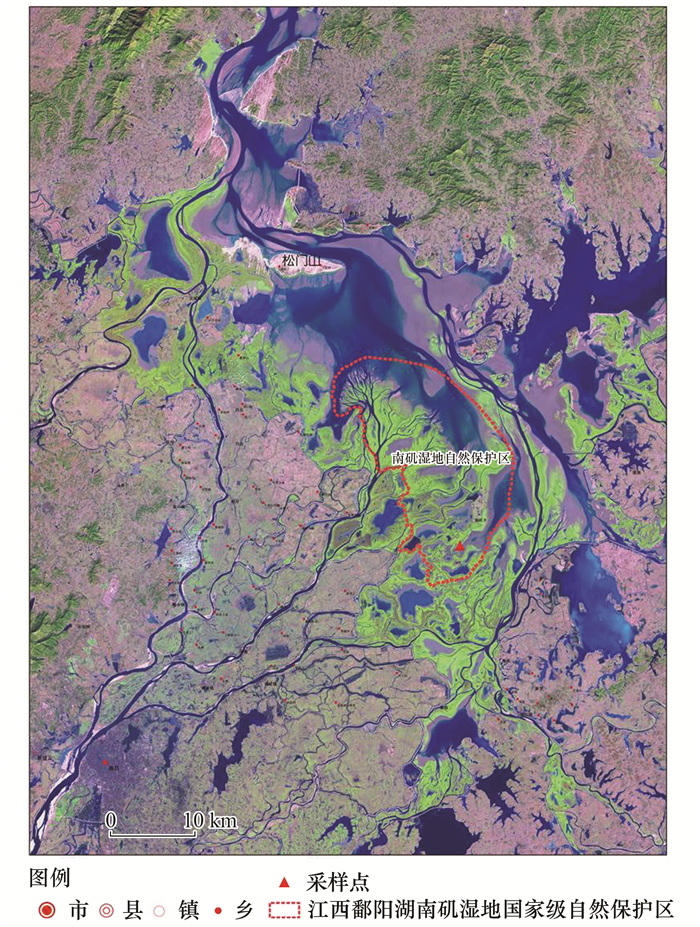
|
底图为1999年12月26日TM遥感影像图, 合成方案:B5B4B3(RGB), 蓝色代表水体, 绿色代表植被 图 1 采样点分布示意 Fig. 1 Distribution of sample sites |
经过实际调查发现白沙湖已被当地渔民承包用于养鱼, 湖周被围了起来, 与其他湖区隔开, 湖水基本不流动, 人类无法直接到达候鸟栖息地, 所以候鸟栖息地人类干扰很小.选择枯水期(11月)对湖岸边人类活动区域、湖中心和侯鸟活动区域进行水体、底泥及候鸟粪便的采样(表 1)[12], 侯鸟主要为鸿雁.
|
|
表 1 采样点信息 Table 1 Information for the sampling sites |
1.2 样品采集
水体的采集采用拖网的方式, 采集好后装在采样瓶中, 采样瓶在实验室利用去离子水清洗干净防止污染.对于底泥的采集每个采样点设置3个小样方, 用铲子收集表层2 cm的底泥, 每个样方相隔50 m[13].底泥样品收集后被保存在采样袋中, 尽快运回实验室, 然后风干, 干燥后保存于采样袋中以待分析, 在此过程中应尽量避免污染.在草滩上使用采样勺采集新鲜的鸟类粪便, 收集后保存在采样袋中, 运回实验室后在70℃下烘至恒重.
1.3 样品分离对于水体样品中微塑料的分离较为简单, 可直接将采集的水样通过滤膜进行过滤来收集微塑料.由于湖中水草较多, 在拖网采集的水样中也混入了较多水草, 干扰了微塑料的收集, 因此在过滤之前对水样进行了消解, 所选的消解液为KOH[14], 加入KOH (100 g·L-1)后置于恒温摇床上加热并振荡, 温度设置为60℃, 待消解液体变澄清后加入饱和氯化钠溶液浮选, 静置后用真空抽滤装置(GM- 0.33A)抽滤, 收集抽滤后的滤膜(孔径5 μm), 将滤膜保留于玻璃皿中以待下一步分析.
底泥样品通过密度分离法分离微塑料.具体步骤:称取1 kg土壤样品(干重)分别经过1 mm和2 mm筛, 1~2 mm和>2 mm的材料保存在筛内用肉眼进行微塑料的检查.过筛的样品(<1 mm)被转移至分离装置中进行密度分离, 先用饱和氯化钠溶液(密度为1.2 g·cm-3)浮选, 获得初步分离样品, 然后再用饱和氯化钠溶液进行进一步的浮选分离, 收集上清液, 用真空抽滤装置抽滤, 收集抽滤后的滤膜(孔径5 μm), 保留滤膜于玻璃皿中以待下一步分析.
在实验室中, 称取1 g(干重)鸟类粪便于1 L干净的高型烧杯中, 取30 mL KOH (100 g·L-1)加入烧杯中进行消解, 在水浴锅中加热至60℃, 待消解液变澄清后冷却.然后将冷却后的消解液中加入饱和盐溶液(过5 μm滤膜)500 mL, 静置过夜; 取上清液进行抽滤(5 μm滤膜), 保留滤膜于玻璃皿中.整个过程中尽量保持样品不受周围环境的污染.本实验中都设置空白对照组.
1.4 微塑料特征鉴定将分离浮选得到的滤膜置于金相显微镜(上海精密仪器公司)下, 观察各类微塑料外观及形态等特征.用Nano Measuer 1.2软件进行计数, 粒径以微塑料最长一边的长度测量.并结合红外光谱法对微塑料样品进行鉴定和表征[15].本研究采用型号为Nicolet 6700的红外光谱仪测定样品.
1.5 数据处理采用SPASS 13.0进行单因素方差分析(One Way ANOVA)并进行不同采样点微塑料丰度的差异显著性检验.
2 结果与分析 2.1 研究区水体、底泥和候鸟粪便中的微塑料丰度和类型 2.1.1 研究区微塑料丰度研究区不同采样点水体中微塑料丰度有较大差异.其中湖中心微塑料丰度最小, 其次是湖岸边, 候鸟活动区域微塑料最高, 显著高于其他区域(P<0.05), 其微塑料丰度可达(710.26±242.07)个·m-3, 平均丰度263.28个·m-3.研究区不同采样点底泥中微塑料丰度亦各不相同.表现为湖中心[(112.1±25.2)个·kg-1]<湖岸边[(201.8±35.9)个·kg-1]<候鸟活动区域[(333.9±134.8)个·kg-1], 平均丰度215.9个·kg-1.在候鸟活动区域采集的15份粪便样品中均发现了微塑料的存在, 丰度从1~15个不等, 平均丰度为(4.93±4.25)个·g-1(表 2).
|
|
表 2 研究区微塑料丰度1) Table 2 Abundance of microplastics in the study area |
2.1.2 研究区微塑料类型
研究区微塑料存在颗粒、薄膜、碎片和纤维这4种不同形貌的微塑料, 颗粒类微塑料为红色和紫色, 形状规则, 一般为球形; 薄膜类微塑料较为透明[图 2(b)和2(c)], 无规则的膜状, 且质地轻而软; 碎片类微塑料主要是硬质塑料碎片, 硬质塑料碎片[图 2(d)]的颜色多样, 形状规则, 但多数有破损边缘; 纤维类微塑料主要为破损的渔线或渔网, 颜色大多为蓝色或红色[图 2(e)和2(f)].

|
(a)红色颗粒类; (b)紫色颗粒和蓝色薄膜; (c)红色薄膜; (d)红色碎片; (e)红色纤维; (f)蓝色纤维 图 2 研究区不同类型微塑料显微图 Fig. 2 Micrographs of different types of microplastics in the study area |
研究区水体中存在颗粒、薄膜、碎片和纤维这4种不同形貌的微塑料, 其中颗粒类微塑料最多, 不同采样点微塑料类型相同(图 3), 但丰度差异较大.研究区内水体中提取的微塑料颜色主要有红色、黄色、绿色、蓝色、紫色、黑色和透明, 不同采样点水体中红色微塑料均最多(图 4).不同采样点水体中微塑料粒径丰度表现为<1 mm>1~2 mm>2~3 mm>3~5 mm, 且基本呈随粒径增大丰度减小的趋势(图 5).
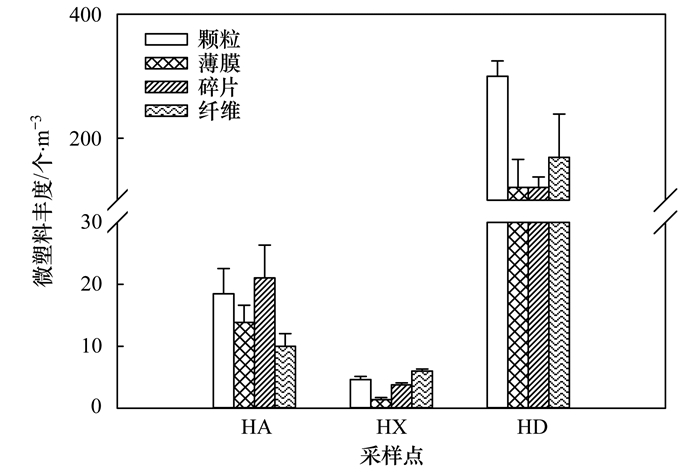
|
图 3 不同采样点水体中微塑料类型 Fig. 3 Types of microplastics in surface water at different sampling sites |
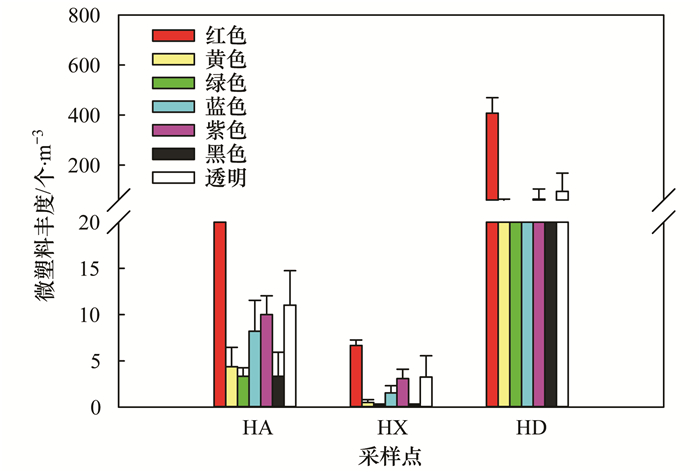
|
图 4 不同采样点水体中微塑料颜色 Fig. 4 Color of microplastics in surface water at different sampling sites |
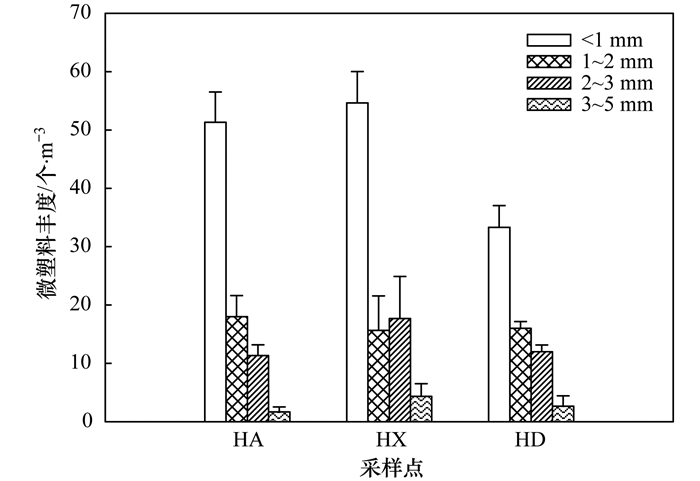
|
图 5 不同采样点水体中微塑料粒径 Fig. 5 Size of microplastics in surface water at different sampling sites |
研究区不同采样点底泥中微塑料组成不同, 湖岸边存在颗粒、薄膜、碎片和纤维这4种不同形貌的微塑料, 而湖中心和候鸟活动区域只有颗粒、薄膜和纤维这3种类型的微塑料(图 6), 湖岸边和候鸟栖息地底泥中微塑料以颗粒和纤维类为主, 而湖中心以薄膜和纤维类为主.研究区内底泥中提取的微塑料颜色主要有红色、黄色、蓝色、紫色、黑色和透明, 其中紫色微塑料丰度最大(图 7).湖岸边和鸟类栖息地微塑料粒径以<1 mm为主, 湖中心以1~2 mm为主(图 8).
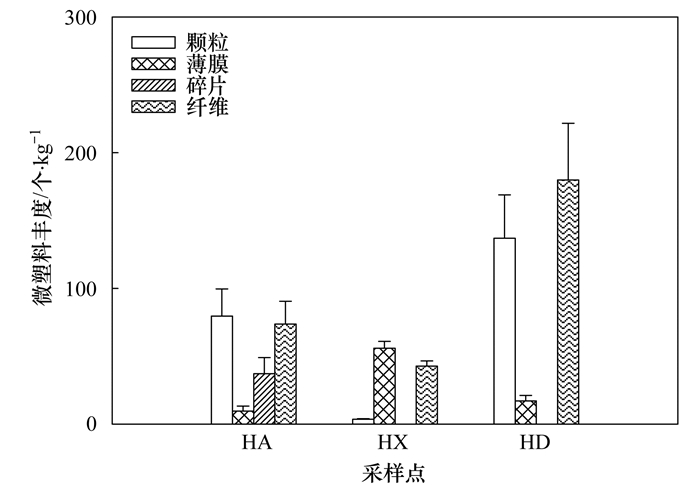
|
图 6 不同采样点底泥中微塑料类型 Fig. 6 Types of microplastics in sediment at different sampling sites |
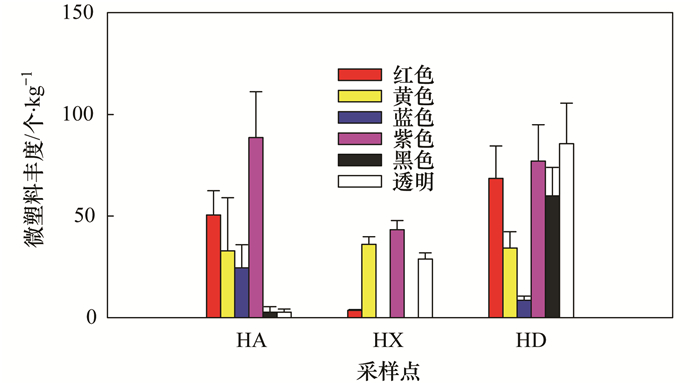
|
图 7 不同采样点底泥中微塑料颜色 Fig. 7 Color of microplastics in sediment at different sampling sites |
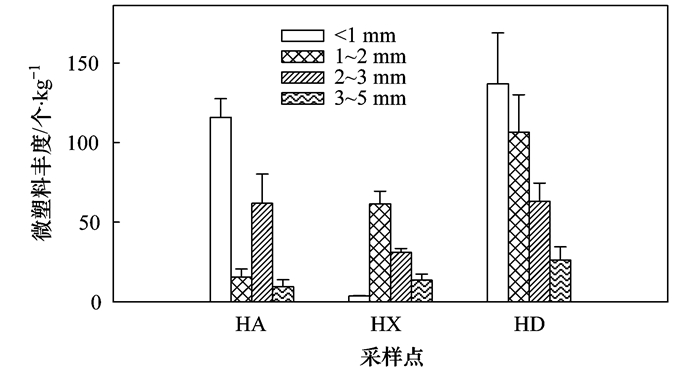
|
图 8 不同采样点底泥中微塑料粒径 Fig. 8 Size of microplastics in sediment at different sampling sites |
候鸟粪便内微塑料主要包括颗粒、薄膜、碎片和纤维这4种类型.微塑料颜色为红色、黄色、绿色、紫色和透明这5种颜色.不同类型微塑料粒径也有差异, 颗粒和碎片类微塑料粒径以<1 mm为主, 而薄膜和纤维类微塑料粒径主要在2~3 mm(表 3).
|
|
表 3 鸟粪便内微塑料类型、颜色和粒径范围 Table 3 Types, colors, and particle sizes of microplastics in bird excrement |
2.5 研究区水体、底泥和鸟粪便中微塑料类型、颜色和粒径数量分布
研究区水体中微塑料类型数量分布表现为颗粒>纤维>碎片>薄膜, 底泥中微塑料类型数量分布表现为纤维>颗粒>薄膜>碎片.而鸟粪便内微塑料数量分布表现为颗粒>碎片>薄膜>纤维.水体、底泥和鸟粪便中微塑料类型无一致性(表 4).研究区水体和鸟粪便中微塑料以红色为主, 而底泥中微塑料以紫色为主(表 5).研究区水体和鸟粪便中微塑料大部分<1 mm, 鸟粪便中微塑料粒径基本与水体中微塑料粒径分布保持一致(表 6).初步可以推断水体中微塑料的分布对鸟类影响较大.
|
|
表 4 研究区水体、底泥和鸟粪便中微塑料类型数量分布/% Table 4 Comparison of the microplastic types in water, sediment, and bird excrement/% |
|
|
表 5 研究区水体、底泥和鸟粪便中微塑料颜色数量分布/% Table 5 Comparison of the microplastic colors in water, sediment, and bird excrement/% |
|
|
表 6 研究区水体、底泥和鸟粪便中微塑料粒径数量分布/% Table 6 Comparation of the microplastics sizes in water, sediment and bird excrement/% |
3 讨论 3.1 候鸟栖息地微塑料污染程度
本研究中, 鄱阳湖南矶湿地国家级自然保护区内的候鸟栖息地白沙湖水体中微塑料丰度范围介于(63.33±7.78)~(710.26±242.07)个·m-3之间, 平均丰度263.28个·m-3, 底泥中微塑料丰度范围介于(121±25.2)个·kg-1~(333.9±134.8)个·kg-1之间, 平均丰度215.9个·kg-1.本研究中, 白沙湖水体中微塑料(<5 mm)丰度高于意大利中部波尔塞纳湖(0.82~4.42个·m-3)和丘西湖(2.68~3.36个·m-3)[16]以及中国最大的内陆湖青海湖表层水的微塑料丰度[17]. Su等[18]的研究表明, 中国太湖表面水中微塑料丰度达3.4~25.8个·L-1, 远高于本研究中白沙湖表面水中的微塑料丰度.白沙湖底泥中的微塑料丰度与意大利中部波尔塞纳湖(112个·kg-1)和丘西湖(234个·kg-1)以及中国太湖(11.0~234.6个·kg-1)底泥中微塑料丰度较为一致.可见, 鄱阳湖湿地候鸟栖息地微塑料污染处于国内外湖泊的中等水平.
3.2 候鸟栖息地微塑料来源分析本研究表明, 白沙湖水体和底泥中的微塑料均包括颗粒、薄膜、碎片和纤维这4种类型.水体中颗粒类微塑料丰度最大, 且在鸟类活动区域微塑料丰度显著高于湖的其他区域.经文献查阅, 微珠来源于生活污水, 其被发现存在于牙膏、沐浴乳和洗面奶及其他各种产品中[19], 但是经过现场调查, 此来源基本可以忽略.此外, 渔船在湖中捕鱼打捞时也会带入一部分的树脂颗粒, 研究区存在此种来源[4], 但是仅是一小部分来源.本研究发现侯鸟栖息地微塑料丰度可达(710.26±242.07)个·m-3, 且以颗粒类微塑料为主, 且在鸟类粪便中也发现了微塑料, 而鸟类活动的浅滩中到处都是鸟类粪便, 且此区域湖水基本不流动, 因此笔者推断此区域颗粒类微塑料可能是鸟类携带过来的, 此推断在Provencher等[7]的研究中得到了证实, 由于颗粒类微塑料粒径较小, 易被鸟类摄入, 大部分又通过粪便排出体外, 从而进入水体, 这样不断积累导致小区域水体中微塑料丰度很高.而底泥中以纤维类微塑料为主, 纤维类微塑料主要来源于养殖网、鱼网和鱼线碎裂所造成[20].薄膜类微塑料主要来源于渔民日常生活中所使用的膜类食品包装袋和鱼饲料编织袋上的防水薄膜层.碎片类微塑料主要来源于一些生活中常用的塑料制品[21], 比如塑料瓶, 实际调查中发现在湖岸边有很多丢弃的塑料瓶.
以往研究表明, 微塑料往往与人类活动有关[22, 23].本研究也得到了相同的结论, 在3个采样点中, 人类活动区域湖岸边的微塑料丰度显著高于人类活动较小的湖中心, 这进一步证实了人为因素在微塑料分布中的重要作用.
3.3 微塑料对生物的影响 3.3.1 生物对微塑料的摄入据统计, 每年有大量的塑料进入环境中并且随着时间的推移这些塑料破碎为微塑料, 由于微塑料体积小, 其可以被低营养级的动物摄入, 对生物体的健康造成不确定的后果[24, 25].大量研究表明微塑料可以被水生生物摄入.有报道称漂浮在海洋上高浓度的塑料和微塑料碎片已经导致了葡萄牙沿海水域海洋浮游生物体内微塑料的存在[26].对微塑料在德国贻贝和牡蛎体内的调查显示, 微塑料存在于这两种贝类的软组织中[27].有研究报道了地中海巴利阿里群岛微塑料在鱼的胃肠道内的存在[28]. Alomar等[10]的研究表明, 微塑料已经在巴利阿里群岛周围的鲨鱼体内被发现. Li等[29]的研究发现微塑料出现在9种中国市场上双壳类动物商品中.本研究在候鸟粪便中发现了微塑料的存在, 表明鸟类也无可避免地接触到了微塑料, 警示人们微塑料将会是候鸟的新威胁.
3.3.2 微塑料对生物体的影响微塑料的数量在全球环境中增加, 对生物造成了一系列的负面影响[30].生物的塑料和微塑料摄入所带来的物理和毒理学作用可能会对物种造成严重威胁[31].近年来, 越来越多的研究尝试探讨微塑料对生物造成的影响. Heindler等[25]的研究结果表明, 微塑料可能会导致生物的生殖障碍, 并且可以遗传给后代.在沙质底泥中传统的和生物可分解的微塑料都会影响海蚯蚓的健康和行为, 并直接或间接地减少这些初级生产力的栖息地[32].在实验条件下, 微聚苯乙烯对海洋贻贝的组织、细胞和分子水平均有直接的毒性作用[33].褐家鼠暴露在高水平的微塑料中可能会减少养分的有效性[34].然而亦有实验研究表明, 微塑料没有堵塞等足类动物的消化器官且没有对它们的生活产生不利影响[35], 微塑料的摄入亦对鱼类的营养水平没有影响[36].关于微塑料对鸟类的影响需要进一步地研究.
4 结论鄱阳湖湿地候鸟栖息地水体中微塑料丰度范围介于(63.33±7.78)~(710.26±242.07)个·m-3之间, 底泥中微塑料丰度范围介于(112.1±25.2)~(333.9±134.8)个·kg-1之间.不同采样点水体中微塑料丰度有较大差异.鸟类粪便中微塑料丰度从1~15个·g-1不等, 平均丰度为(4.93±4.25)个·g-1.研究区微塑料包括颗粒类、薄膜类、碎片类和纤维类这4种类型, 其中颗粒和纤维占比较大, 以红色为主, 且粒径以<1 mm的微塑料占比最大.鸟粪便中微塑料颜色和粒径基本与水体中微塑料粒径分布保持一致, 初步可以推断水体中微塑料的分布对鸟类影响较大.鄱阳湖湿地候鸟栖息地微塑料污染处于国内外湖泊的中等水平.本区域高丰度的颗粒类微塑料来源于鸟类携带, 纤维类主要来源于养殖网、鱼网和鱼线碎裂所造成.此研究表明在无处不在的微塑料污染下鸟类也无可避免地接触到了微塑料, 警示人们微塑料将会是候鸟的新威胁.
| [1] | Wessel C C, Lockridge G R, Battiste D, et al. Abundance and characteristics of microplastics in beach sediments:Insights into microplastic accumulation in northern Gulf of Mexico estuaries[J]. Marine Pollution Bulletin, 2016, 109(1): 178-183. DOI:10.1016/j.marpolbul.2016.06.002 |
| [2] | Ng K L, Obbard J P. Prevalence of microplastics in Singapore's coastal marine environment[J]. Marine Pollution Bulletin, 2006, 52(7): 761-767. DOI:10.1016/j.marpolbul.2005.11.017 |
| [3] | Frias J P G L, Sobral P, Ferreira A M. Organic pollutants in microplastics from two beaches of the Portuguese coast[J]. Marine Pollution Bulletin, 2010, 60(11): 1988-1992. DOI:10.1016/j.marpolbul.2010.07.030 |
| [4] | Fendall L S, Sewell M A. Contributing to marine pollution by washing your face:Microplastics in facial cleansers[J]. Marine Pollution Bulletin, 2009, 58(8): 1225-1228. DOI:10.1016/j.marpolbul.2009.04.025 |
| [5] |
赵其国, 黄国勤, 钱海燕. 鄱阳湖生态环境与可持续发展[J]. 土壤学报, 2007, 44(2): 318-326. Zhao Q G, Huang G Q, Qian H Y. Ecological environment and sustainable development of Poyang Lake[J]. Acta Pedologica Sinica, 2007, 44(2): 318-326. DOI:10.3321/j.issn:0564-3929.2007.02.019 |
| [6] |
周隆胤, 简敏菲, 余厚平, 等. 乐安河-鄱阳湖段底泥微塑料的分布特征及其来源[J]. 土壤学报, 2018, 55(5): 1222-1232. Zhou L Y, Jian M F, Yu H P, et al. Distribution of microplastics and its source in the sediments of the Le'an River in Poyang Lake[J]. Acta Pedologica Sinica, 2018, 55(5): 1222-1232. |
| [7] | Provencher J F, Vermaire J C, Avery-Gomm S, et al. Garbage in guano? Microplastic debris found in faecal precursors of seabirds known to ingest plastics[J]. Science of the Total Environment, 2018, 644: 1477-1484. DOI:10.1016/j.scitotenv.2018.07.101 |
| [8] | Li J N, Qu X Y, Su L, et al. Microplastics in mussels along the coastal waters of China[J]. Environmental Pollution, 2016, 214: 177-184. DOI:10.1016/j.envpol.2016.04.012 |
| [9] | Castro R O, Silva M L, Marques M R C, et al. Evaluation of microplastics in Jurujuba Cove, Niterói, RJ, Brazil, an area of mussels farming[J]. Marine Pollution Bulletin, 2016, 110(1): 555-558. DOI:10.1016/j.marpolbul.2016.05.037 |
| [10] | Alomar C, Deudero S. Evidence of microplastic ingestion in the shark Galeus melastomus Rafinesque, 1810 in the continental shelf off the western Mediterranean Sea[J]. Environmental Pollution, 2017, 223: 223-229. DOI:10.1016/j.envpol.2017.01.015 |
| [11] |
胡振鹏, 葛刚, 刘成林, 等. 鄱阳湖湿地植物生态系统结构及湖水位对其影响研究[J]. 长江流域资源与环境, 2010, 19(6): 597-605. Hu Z P, Ge G, Liu C L, et al. Structure of Poyang Lake wetland plants ecosystem and influence of lake water level for the structure[J]. Resources and Environment in the Yangtze Basin, 2010, 19(6): 597-605. |
| [12] |
简敏菲, 李玲玉, 余厚平, 等. 鄱阳湖湿地水体与底泥重金属污染及其对沉水植物群落的影响[J]. 生态环境学报, 2015, 24(1): 96-105. Jian M F, Li L Y, Yu H P, et al. Heavy Metals pollution on the water and sediments and its influence on the submerged macrophyte community in the wetland of Poyang Lake[J]. Ecology and Environmental Sciences, 2015, 24(1): 96-105. |
| [13] | Cooper D A, Corcoran P L. Effects of mechanical and chemical processes on the degradation of plastic beach debris on the island of Kauai, Hawaii[J]. Marine Pollution Bulletin, 2010, 60(5): 650-654. DOI:10.1016/j.marpolbul.2009.12.026 |
| [14] |
邹亚丹, 徐擎擎, 张哿, 等. 6种消解方法对荧光测定生物体内聚苯乙烯微塑料的影响[J]. 环境科学, 2019, 40(1): 496-503. Zou Y D, Xu Q Q, Zhang G, et al. Influence of six digestion methods on the determination of polystyrene microplastics in organisms using the fluorescence intensity[J]. Environmental Science, 2019, 40(1): 496-503. |
| [15] | Harrison J P, Ojeda J J, Romero-González M E. The applicability of reflectance micro-fourier-transform infrared spectroscopy for the detection of synthetic microplastics in marine sediments[J]. Science of the Total Environment, 2012, 416: 455-463. DOI:10.1016/j.scitotenv.2011.11.078 |
| [16] | Fischer E K, Paglialonga L, Czech E, et al. Microplastic pollution in lakes and lake shoreline sediments-A case study on Lake Bolsena and Lake Chiusi (central Italy)[J]. Environmental Pollution, 2016, 213: 648-657. DOI:10.1016/j.envpol.2016.03.012 |
| [17] | Xiong X, Zhang K, Chen X C, et al. Sources and distribution of microplastics in China's largest inland lake-Qinghai Lake[J]. Environmental Pollution, 2018, 235: 899-906. DOI:10.1016/j.envpol.2017.12.081 |
| [18] | Su L, Xue Y G, Li L Y, et al. Microplastics in Taihu Lake, China[J]. Environmental Pollution, 2016, 216: 711-719. DOI:10.1016/j.envpol.2016.06.036 |
| [19] | Tsang Y Y, Mak C W, Liebich C, et al. Microplastic pollution in the marine waters and sediments of Hong Kong[J]. Marine Pollution Bulletin, 2017, 115(1-2): 20-28. DOI:10.1016/j.marpolbul.2016.11.003 |
| [20] |
刘启明, 梁海涛, 锡桂莉, 等. 厦门湾海滩微塑料污染特征[J]. 环境科学, 2019, 40(3): 1217-1221. Liu Q M, Liang H T, Xi G L, et al. Microplastic pollution of the beaches in Xiamen Bay, China[J]. Environmental Science, 2019, 40(3): 1217-1221. |
| [21] | Wu W M, Yang J, Criddle C S. Microplastics pollution and reduction strategies[J]. Frontiers of Environmental Science & Engineering, 2017, 11(1): 6. |
| [22] | Castillo A B, Al-Maslamani I, Obbard J P. Prevalence of microplastics in the marine waters of Qatar[J]. Marine Pollution Bulletin, 2016, 111(1-2): 260-267. DOI:10.1016/j.marpolbul.2016.06.108 |
| [23] | Nel H A, Hean J W, Noundou X S, et al. Do microplastic loads reflect the population demographics along the southern African coastline?[J]. Marine Pollution Bulletin, 2017, 115(1-2): 115-119. DOI:10.1016/j.marpolbul.2016.11.056 |
| [24] | Wright S L, Thompson R C, Galloway T S. The physical impacts of microplastics on marine organisms:a review[J]. Environmental Pollution, 2013, 178: 483-492. DOI:10.1016/j.envpol.2013.02.031 |
| [25] | Heindler F M, Alajmi F, Huerlimann R, et al. Toxic effects of polyethylene terephthalate microparticles and Di(2-ethylhexyl)phthalate on the calanoid copepod, Parvocalanus crassirostris[J]. Ecotoxicology and Environmental Safety, 2017, 141: 298-305. DOI:10.1016/j.ecoenv.2017.03.029 |
| [26] | Frias J P G L, Otero V, Sobral P. Evidence of microplastics in samples of zooplankton from Portuguese coastal waters[J]. Marine Environmental Research, 2014, 95: 89-95. DOI:10.1016/j.marenvres.2014.01.001 |
| [27] | Van Cauwenberghe L, Janssen C R. Microplastics in bivalves cultured for human consumption[J]. Environmental Pollution, 2014, 193: 65-70. DOI:10.1016/j.envpol.2014.06.010 |
| [28] | Nadal M A, Alomar C, Deudero S. High levels of microplastic ingestion by the semipelagic fish bogue Boops boops(L.) around the Balearic Islands[J]. Environmental Pollution, 2016, 214: 517-523. DOI:10.1016/j.envpol.2016.04.054 |
| [29] | Li J N, Yang D Q, Li L, et al. Microplastics in commercial bivalves from China[J]. Environmental Pollution, 2015, 207: 190-195. DOI:10.1016/j.envpol.2015.09.018 |
| [30] | Laglbauer B J L, Franco-Santos R M, Andreu-Cazenave M, et al. Macrodebris and microplastics from beaches in Slovenia[J]. Marine Pollution Bulletin, 2014, 89(1-2): 356-366. DOI:10.1016/j.marpolbul.2014.09.036 |
| [31] | Baini M, Martellini T, Cincinelli A, et al. First detection of seven phthalate esters (PAEs) as plastic tracers in superficial neustonic/planktonic samples and cetacean blubber[J]. Analytical Methods, 2017, 9(9): 1512-1520. DOI:10.1039/C6AY02674E |
| [32] | Green D S, Boots B, Sigwart J, et al. Effects of conventional and biodegradable microplastics on a marine ecosystem engineer (Arenicola marina) and sediment nutrient cycling[J]. Environmental Pollution, 2016, 208: 426-434. DOI:10.1016/j.envpol.2015.10.010 |
| [33] | Paul-Pont I, Lacroix C, Fernández C G, et al. Exposure of marine mussels Mytilus spp. to polystyrene microplastics:Toxicity and influence on fluoranthene bioaccumulation[J]. Environmental Pollution, 2016, 216: 724-737. DOI:10.1016/j.envpol.2016.06.039 |
| [34] | Welden N A C, Cowie P R. Long-term microplastic retention causes reduced body condition in the langoustine, Nephrops norvegicus[J]. Environmental Pollution, 2016, 218: 895-900. DOI:10.1016/j.envpol.2016.08.020 |
| [35] | Hämer J, Gutow L, Köhler A, et al. Fate of microplastics in the marine isopod Idotea emarginata[J]. Environmental Science & Technology, 2014, 48(22): 13451-13458. |
| [36] | Güven O, Gökdağ K, Jovanović B, et al. Microplastic litter composition of the Turkish territorial waters of the Mediterranean Sea, and its occurrence in the gastrointestinal tract of fish[J]. Environmental Pollution, 2017, 223: 286-294. DOI:10.1016/j.envpol.2017.01.025 |
 2019, Vol. 40
2019, Vol. 40


